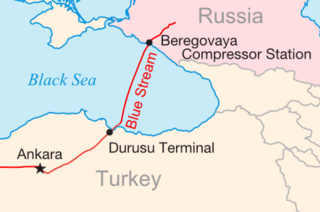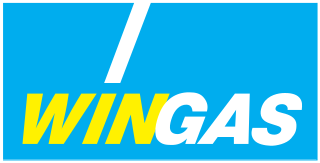
PJSC Gazprom is a Russian majority state-owned multinational energy corporation headquartered in the Lakhta Center in Saint Petersburg. As of 2019, with sales over $120,000,000,000, it was ranked as the largest publicly listed natural gas company in the world and the largest company in Russia by revenue. In the 2020 Forbes Global 2000, Gazprom was ranked as the 32nd -largest public company in the world. The Gazprom name is a contraction of the Russian words gazovaya promyshlennost. In January 2022, Gazprom displaced Sberbank from the first place in the list of the largest companies in Russia by market capitalization.
The Shtokman field, one of the world's largest natural gas fields, lies in the northwestern part of the South Barents Basin in the Russian sector of the Barents Sea, 600 kilometres (370 mi) north of Kola Peninsula. Its reserves are estimated at 3.8 trillion cubic metres of natural gas and more than 37 million tons of gas condensate.

Blue Stream is a major trans-Black Sea gas pipeline that carries natural gas to Turkey from Russia. The pipeline has been constructed by the Blue Stream Pipeline B.V., the Netherlands based joint venture of Russian Gazprom and Italian Eni. The Blue Stream Pipeline B.V. is an owner of the subsea section of pipeline, including Beregovaya compressor station, while Gazprom owns and operates the Russian land section of the pipeline and the Turkish land section is owned and operated by the Turkish energy company BOTAŞ. According to Gazprom the pipeline was built with the intent of diversifying Russian gas delivery routes to Turkey and avoiding third countries.

Nord Stream is a pair of offshore natural gas pipelines in Europe that runs under the Baltic Sea from Russia to Germany. It comprises the Nord Stream 1 (NS1) pipeline running from Vyborg in northwestern Russia, near Finland, and the Nord Stream 2 (NS2) pipeline running from Ust-Luga in northwestern Russia near Estonia. Both pipelines run to Lubmin in the northeastern German state of Mecklenburg-Vorpommern. Each pipeline comprises two pipes, denoted A and B, each of the four pipes being approximately 1,200 kilometres (750 mi) long and with approximate diameters of 1,220 millimetres (48 in). The combined capacity of the four pipes is 110 million cubic metres per annum of natural gas.

The BBL Pipeline is a natural gas interconnector between the Netherlands and the United Kingdom.

Wintershall Holding GmbH, based in Kassel, was Germany's largest crude oil and natural gas producer. It was a wholly owned subsidiary of BASF. The company was active in oil and gas exploration and production with operations in Europe, North Africa, South America as well as Russia and the Middle East region. Wintershall employed more than 2,000 people worldwide. In the 2018 financial year the company produced around 171 million barrels of oil equivalent (boe) of oil and gas. Revenues amounted to 4.09 billion euros.

The petroleum industry in Russia is one of the largest in the world. Russia has the largest reserves and is the largest exporter of natural gas. It has the second largest coal reserves, the sixth largest oil reserves, and is one of the largest producers of oil. It is the fourth largest energy user.

South Stream was a failed pipeline project to transport natural gas of the Russian Federation through the Black Sea to Bulgaria and through Serbia, Hungary and Slovenia further to Austria. It was never finished.
Peak gas is the year in which the maximum global natural gas production rate will be reached, after which the rate of production will enter its terminal decline. Although demand is peaking in the United States and Europe, it continues to rise globally due to consumers in Asia, especially China. Natural gas is a fossil fuel formed from plant matter over the course of millions of years. Natural gas derived from fossil fuels is a non-renewable energy source; however, methane can be renewable in other forms such as biogas. Peak coal was in 2013, and peak oil is forecast to occur before peak gas. One forecast is for natural gas demand to peak in 2035.
The Kovykta gas condensate field is one of the largest undeveloped natural gas fields in Eastern Siberia, Russia. The field is located in the northern part of the Irkutsk Oblast, in the Zhigalovo and Kazachinsko-Lensk districts.
Ruhrgas AG was the largest natural gas transportation and trading company based in Essen, Germany. The company was founded in 1926 and it finally ceased to exist on 2 May 2013 when it was merged into E.ON Global Commodities SE.

Wingas GmbH is a gas distribution company located in Kassel, Germany. It is a subsidiary of Gazprom, which held its shares through W&G Beteilligungs-GmbH & Co. KG.
Yamal project, also referred to as Yamal megaproject, is a long-term plan to exploit and bring to the markets the vast natural gas reserves in the Yamal Peninsula, Russia. Administratively, the project is located in the Yamalo-Nenets Autonomous Okrug. The project is developed by Gazprom.

Russia supplies a significant volume of fossil fuels to other European countries. In 2021, it was the largest exporter of oil and natural gas to the European Union, and 40% of gas consumed in the EU came from Russia.
The Mozdok–Makhachkala–Kazi Magomed pipeline is a natural gas pipeline from Mozdok in North Ossetia through Chechnya and Dagestan to Azerbaijan. The Azerbaijani section is also known as the Kazi Magomed–Novo Filya or Baku–Novo Filya, and it connects Baku with the Novo Filya gas metering utility on the Russian side of the Azerbaijan-Russia border. The pipeline will be used for transportation of Azerbaijani gas to Russia starting from 1 January 2010.
Ukraine has been estimated to possess natural gas reserves of over 1 trillion cubic meters and in 2018 was ranked 26th among countries with proved reserves of natural gas. Its total gas reserves have been estimated at 5.4 trillion cubic meters. In 2021, Ukraine produced 19.8 billion cubic meters (bcm or Gm3) of natural gas. To satisfy domestic demand of 27.3 bcm that year, Ukraine relied on gas imports (2.6 bcm) and withdrawal from underground storage (4.9 bcm). Winter demand can reach 150 mcm per day. To meet domestic demand, Ukraine plans to increase domestic natural gas output to 27 bcm.

Romania has proven natural gas reserves of 726 billion cubic meters and is ranked 30th among countries with proved reserves of natural gas. About 75% of Romania's natural gas resources are located in Transylvania, especially in Mureș and Sibiu counties. The largest natural gas field in Romania is the Deleni gas field discovered in 1912 and located in the Băgaciu commune in Mureș County with proven reserves of 85 billion cubic meters or 3 trillion cubic feet. Other important gas fields include the Filitelnic gas field, the Roman-Secuieni gas field, the Voitinel gas field, the Ghercești gas field and the Sărmașel gas field all with reserves larger than 10 billion cubic meters or 350 billion cubic feet. Currently Romania has the second largest natural gas reserves in the European Union just after the Netherlands.
The Russkoye field is a heavy crude oil field located in the Tazovsky District, Yamalo-Nenets Autonomous Okrug, Russia. It is one of the largest fields in Russia. The field is developed by Tyumenneftegaz, a former subsidiary of TNK-BP and the current subsidiary of Rosneft.

As of 2013, Russia is the world's second-largest producer of natural gas, producing an estimated more than 669 billion cubic meters (bcm) of gas a year, and the world's largest natural gas exporter, shipping an estimated 196 bcm a year.












